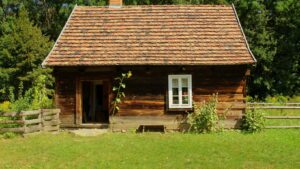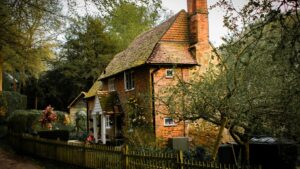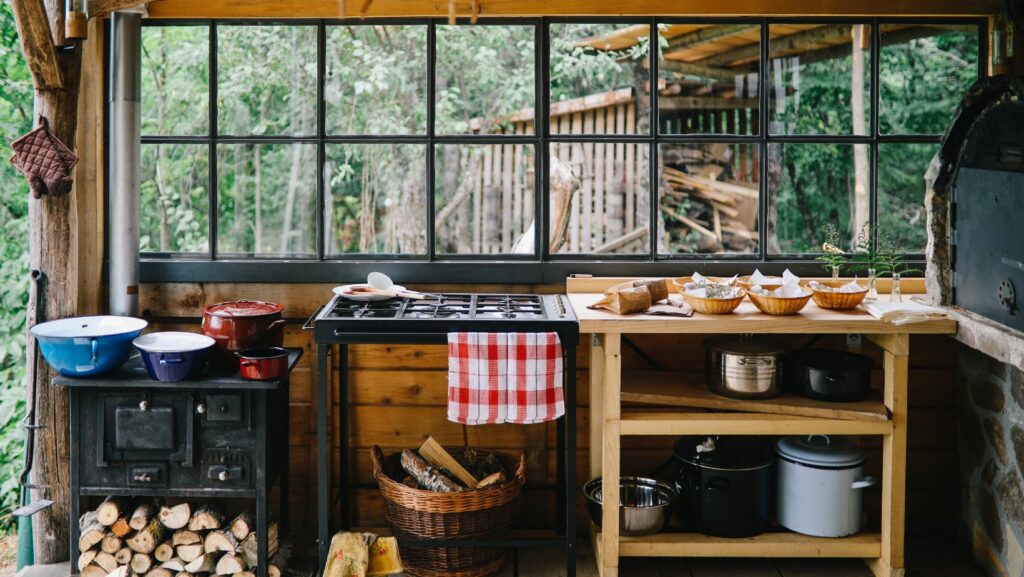Nestled in the heart of nature, the charm of a cottage is undeniable. It’s a style that evokes tranquility, warmth, and a sense of timelessness. From quaint English countryside homes to modern minimalist designs, the cottage architectural style has evolved, yet it retains its signature elements.
So, let’s delve into the intriguing world of cottage architecture, exploring its history, key features, and why it continues to captivate homeowners and architects alike.
Cottage Architectural Style
 Born out of rural simplicity and lasting familiarity, the cottage architectural style displays a unique charm that draws people in. This style, rooted in England, carries significant influence from medieval European country homes and often nods to eclectic English Tudor features. Generally, cottage architecture explores a less formal, more organic aesthetic. It’s defined by low, sloping roofs and small, irregular layouts often characterized by a cosy single story or one-and-a-half stories. Other distinctive elements include arched doors, casement windows, and traditional building materials like stone, timber, and thatch. Hardy construction blends seamlessly with arresting visual appeal, creating a balance between durability and aesthetic value. Though variations exist across different regions, the allure of cottage architecture lies in its timeless, intimate, and idiosyncratically English charm. Deliberate rustic quirks and quaint, picturesque profiles make cottages a testament to pragmatic compact living paired with undeniable allure.
Born out of rural simplicity and lasting familiarity, the cottage architectural style displays a unique charm that draws people in. This style, rooted in England, carries significant influence from medieval European country homes and often nods to eclectic English Tudor features. Generally, cottage architecture explores a less formal, more organic aesthetic. It’s defined by low, sloping roofs and small, irregular layouts often characterized by a cosy single story or one-and-a-half stories. Other distinctive elements include arched doors, casement windows, and traditional building materials like stone, timber, and thatch. Hardy construction blends seamlessly with arresting visual appeal, creating a balance between durability and aesthetic value. Though variations exist across different regions, the allure of cottage architecture lies in its timeless, intimate, and idiosyncratically English charm. Deliberate rustic quirks and quaint, picturesque profiles make cottages a testament to pragmatic compact living paired with undeniable allure.
Key Elements of Cottage Design
 Diving deeper, cottage design flaunts unique elements that enrich its quaint charm. Visible, stout chimneys, usually at the heart of the home, distribute the warmth efficiently, fostering a cozy atmosphere. Exposed wooden beams, typical in older cottages, add rusticity and older world aesthetic to the living space. On the exterior, stone walls provide both resilience and an earthy look, complementing the surrounding landscape effortlessly. Small casement windows, another signature feature, allow sunshine to dance in, creating enchanting light patterns inside the building. The irregularity of room layouts, breaking the straight-line monotony, brings a sense of idiosyncratic personality. Lastly, an entrance with an arched door adds character and endears cottages to people, reflecting the inviting spirit of this distinctive design.
Diving deeper, cottage design flaunts unique elements that enrich its quaint charm. Visible, stout chimneys, usually at the heart of the home, distribute the warmth efficiently, fostering a cozy atmosphere. Exposed wooden beams, typical in older cottages, add rusticity and older world aesthetic to the living space. On the exterior, stone walls provide both resilience and an earthy look, complementing the surrounding landscape effortlessly. Small casement windows, another signature feature, allow sunshine to dance in, creating enchanting light patterns inside the building. The irregularity of room layouts, breaking the straight-line monotony, brings a sense of idiosyncratic personality. Lastly, an entrance with an arched door adds character and endears cottages to people, reflecting the inviting spirit of this distinctive design.
Variations in Cottage Architectural Style
Despite a shared basis in English Tudor influences and rural simplicity, diversity thrives within the realm of cottage architecture. It’s witnessed in the evolution of distinct versions around the globe, each flaunting unique adaptations to climate, culture, and environment.
On one side, in France, the highly popular French Country Cottage spotlights limestone walls, steep hipped roofs, and tall, narrow windows. Meanwhile, Ireland’s stone-built Irish Cottages exhibit a cosy aura through thatch roofs, irregular floor plans, and fireplaces in each room.
 Down under in Australia, Federation Cottages burst onto the scene with deep, sheltering verandahs, exposed rafter ends, and red terracotta roofs. Awestruck by the panoramic Rocky Mountain range, the classic American Mountain Cottages blend seamlessly into the landscape, bearing steep, multi-gabled roofs, expansive windows, and timber exteriors with stone accents.
Down under in Australia, Federation Cottages burst onto the scene with deep, sheltering verandahs, exposed rafter ends, and red terracotta roofs. Awestruck by the panoramic Rocky Mountain range, the classic American Mountain Cottages blend seamlessly into the landscape, bearing steep, multi-gabled roofs, expansive windows, and timber exteriors with stone accents.
In the Asian continent, Bali’s Tropical Cottages adapt to the humid climate, incorporating wide overhanging roofs, large windows, and open floor plans to maximize airflow. Each variant of these nuanced cottages manifests distinguished design elements, unifying under the cottage architectural style’s inclusive canopy.
Modern Adaptations of Cottage Style Architecture
Cottage style architecture, with its strong roots in simplicity and English Tudor influences, has evolved and adapted globally. These adaptations reflect regional climate, culture, and environment, leading to a diverse range of cottage styles. Modern adaptations have kept the essence of the traditional cottage intact while integrating contemporary design elements. Be it the rustic charm of French Country Cottages, the rugged allure of American Mountain Cottages, or the exotic appeal of Bali’s Tropical Cottages, each variant adds a unique flavor to the overarching cottage architectural style. Today, the cottage architectural style continues to captivate homeowners and architects alike with its blend of timeless elegance, functionality, and warmth. It serves as a testament to the enduring appeal of simplicity and tranquility in architectural design.

